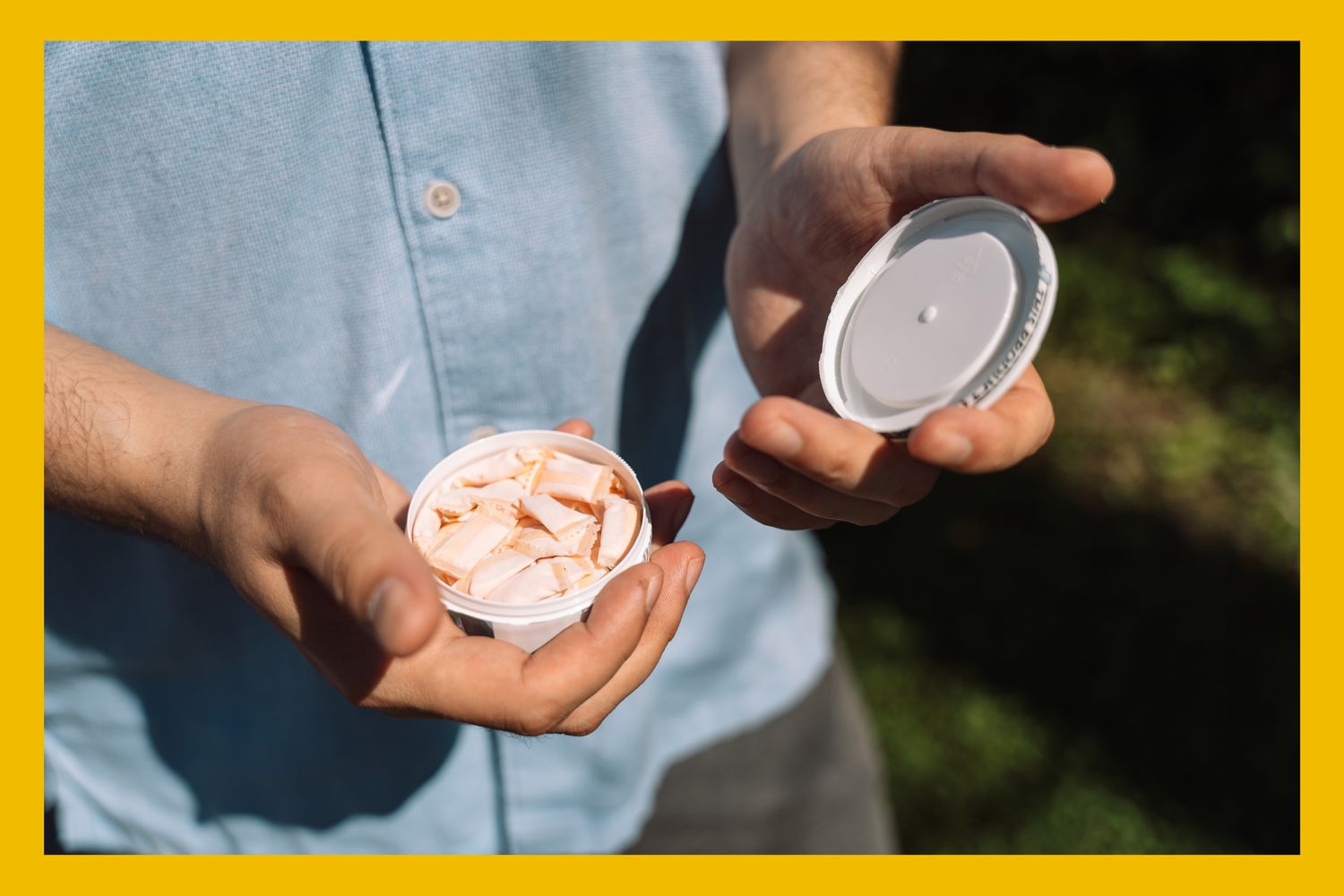:max_bytes(150000):strip_icc():format(jpeg)/NicotinePouches-5277ccbb911e4339bd3f09db543a7f21.jpg)
Just when you thought you had it all figured out about vaping, the tobacco industry introduces another low-key nicotine product that appeals to the younger generation – nicotine pouches. And if you’re like most parents, you not only don’t know these products exist, but you wouldn’t be able to identify them even if you saw them.
In fact, a recent survey conducted by The Ohio State University Comprehensive Cancer Center – Arthur G. James Hospital and Richard J. Solove Research Institute (OSUCCC – James) found that only 25% of adults can identify oral nicotine pouches.
Parents/Anastassiya Bezhekeneva via Getty Images
“While nearly 70 percent of adults believe that using nicotine pouches may lead to addiction, only 25 percent believe they can identify a nicotine pouch from the container,” said research epidemiologist Dr. Brittney Keller-Hamilton, OSUCCC (James Tobacco Research Center) Nicotine Pouch Use and Regulation.
This is a shocking statistic considering there is little regulation of these products and how easy it is for minors to purchase them online. When young people buy this kind of bag online, they only need to enter their birthday to purchase the product. In April, the U.S. Food and Drug Administration issued warning letters to online retailers and 119 letters to brick-and-mortar retailers for selling products to minors.
What are nicotine pouches?
A nicotine pouch is a tobacco product that is placed between the user’s lips and gums, allowing nicotine to be absorbed into the body. These products do not contain tobacco leaves. Instead, they’re made with nicotine powder or salt and flavoring, and don’t require spitting.
How many young people use nicotine pouches?
Keller-Hamilton said there isn’t much rigorous national data on Gen Z’s nicotine pouch use. But she pointed to a survey of college students that found 12 percent reported using nicotine pouches. Meanwhile, about 1.8 percent of middle and high school students report using nicotine pouches, according to the Centers for Disease Control and Prevention’s National Youth Tobacco Survey. This number is only a slight increase from 2023 (1.5%)
“While it is encouraging to see that these numbers remain relatively low for now, the bottom line is that we are cautious about any product that appeals to young people,” said Brian King, Ph.D., M.P.H., director of the FDA’s Center for Tobacco Products, in a press release. “Our alert has been heightened. We are aware of the reported growing sales trend of nicotine pouches and are closely monitoring the changing tobacco product landscape to prevent threats to public health, especially for children. threaten.
The CDC report does indicate, however, that more than 22 percent of people who use nicotine pouches say they use them every day.
Some other reports suggest usage may be rising. Earlier this year, Phillip Morris, the maker of the popular nicotine bag Zyn, reported sales of 131.6 million cans of the product. These sales were up 80% from the same period last year.
Other nicotine pouch brands include Rogue, on! and Velo, but Zyn accounts for nearly three-quarters of nicotine pouch sales, according to Phillip Morris. There are dozens of nicotine pouches floating around that parents may not be able to identify.
Additionally, addiction experts warn that young people, especially Gen Z, may be tempted to use them because of their wariness. This generation also appreciates that pouches allow them to use nicotine without the same effects of smoking, vaping or chewing tobacco. Modern packaging, ease of use, and a variety of flavors also make it a socially acceptable way to get nicotine.
“Research on substance use demonstrates that as risk perceptions decrease, the likelihood of drug use increases; and vice versa,” said Caroline Sahbah, LPC-S, LCDC, MBA, associate director of Counseling and Substance Use and Recovery Services at TCU . “Perceptions of risk are lower for nicotine pouches compared to cigarettes or other smokable products. Because there is no lighter or smoke involved, young people may not view the product as high risk and are therefore more likely to try it for the first time. Or keep using it.
What are the risks of nicotine pouches?
Experts like Keller-Hamilton are concerned about the addictive nature of these pouches, noting that they could provide a gateway to future tobacco product addiction among Generation Z. The pipe won’t go on.
Anthony Hudson, MD, a pediatrician at Children’s Hospital of New Orleans, says young people may be attracted to nicotine pouches because they boost energy and relieve feelings of tension or stress. “These pleasant effects are just one of the reasons people use [the pouches] Addicted.
However, if used regularly, nicotine pouches may also lead to the use of other substances, Dr. Hudson said. “Research shows that nicotine is likely to contribute to substance use disorders.”
Nicotine pouches can also irritate the mouth and gums, leading to ulcers, gum recession and oral health problems, said Dr. Ryan Marino, a psychiatrist and assistant professor at the CWRU School of Medicine at Case Western Reserve University. “Nicotine use among adolescents, especially long-term or heavy use, may affect brain development and lead to long-term disability and other health problems.”
For example, Saba said the bags may cause increased blood pressure, lung and stomach problems and have harmful effects on the brain. “The adolescent brain is still in the critical developmental period from adolescence to adulthood…Using nicotine or other stimulants can increase impulsivity and reduce concentration. [and] focus.
How to identify a nicotine bag
Because nicotine pouches don’t emit smoke, vapor or a noticeable odor, Saba said, it’s difficult to tell if someone is using them. “Also, packaging can include bright colors or photos and may even resemble a candy product.”
Instead, pay attention to any sudden changes in behavior, such as increased secrecy or withdrawal from family activities, advises Kristie Tse, a New York-based psychotherapist and clinical director of Uncover mental health counseling. Also, pay attention to whether your child is easily irritable or anxious. Even a regular visit to the dentist can reveal mouth sores or gum problems caused by nicotine pouches, Xie said. But the best way to find out is to ask them directly.
“Open conversations about peer pressure and the risks associated with these products can create an environment of trust that makes it easier for them to share their experiences,” she said.
What can parents do?
If you find that your teen is experimenting with nicotine pouches, remember that using any substance does not immediately equate to addiction or a substance use disorder.
“Teens may quit drugs easily after talking to their parents. Others may need more support, such as professional help through counseling or other smoking cessation resources,” Saba said.
She also recommends communicating your concerns and expectations and avoiding downplaying their importance by saying “It’s just a bag” or “At least it’s not XYZ.”
“Regardless of what the substance is, substance use can be concerning,” Saba added. “Similarly, as perceptions of risk increase, the likelihood of use decreases. So parents have a crucial role to play in identifying and addressing what those real risks are.”
Additional Tips for Addressing Teen Nicotine Use
According to our experts, here are some other things you can do if you find your teen is trying nicotine pouches:
- Create an environment where they can talk and ask questions without fear of being judged.
- Be honest about the risks.
- Communicate your expectations.
- Help them get the support they need to quit smoking.
- Hold them accountable and set appropriate boundaries.
- Work with them to eliminate any temptation.
- Try to be patient, especially if your child becomes irritable while quitting.
- Address your use of nicotine or other substances (if applicable).




